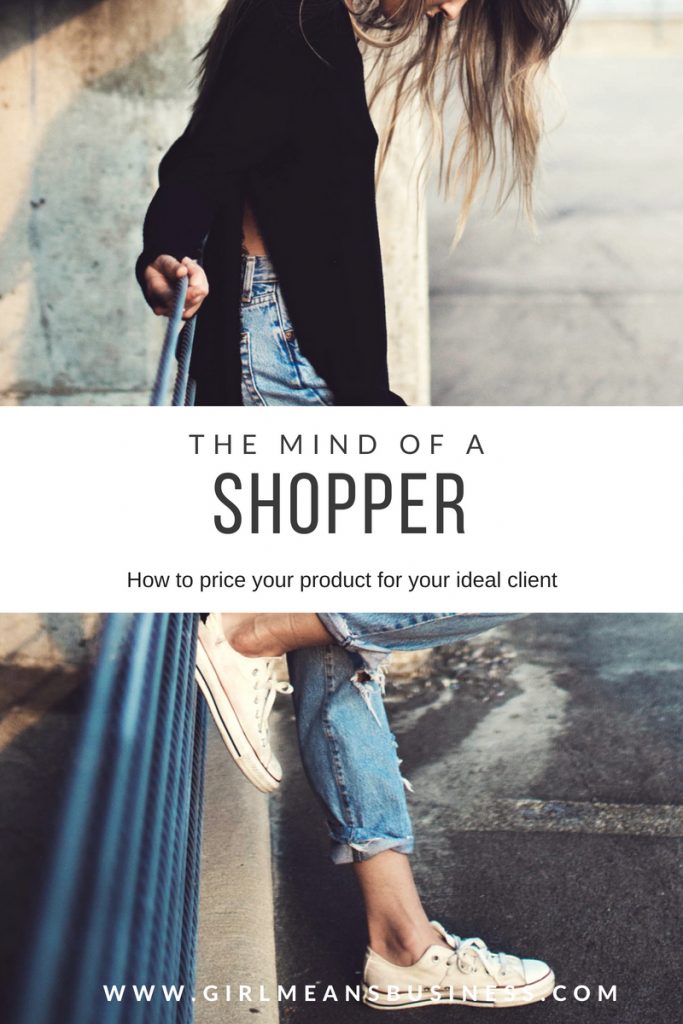
How much should I charge?
This is by far the most popular question among small business owners. Everyone has their opinion on how thing should be priced, what type of business model is best and what your product is worth.
In reality, it’s not up to USwhen it comes to making these decisions. The REALdetermining factor should be yourideal client. They should drive your pricing, business model, marketing plan….just about every aspect of your business.
Yes, this is YOURbusiness, and you should have a say in how it’s run…BUTyou are in the business of providing a product for someone else, so their opinions matter just as much as yours.
So the real question should be…
What type of shopper are you trying to attract?
I like things that are simple, and coming from an a elementary teacher background it’s how my brain works. So when I was asked to describe my ideal client I thought of her as a type of shopper/consumer rather than just a person. I wanted to figure out her shopping habits, mindset and mentality. So I created 4 categories of shoppers. Figure out which shopper is your target client, and the rest will fall into place.
Wal-Mart Shoppers:
These are your bargain shoppers. They don’t care about brand names or top quality products. They want the best deal. These shoppers like to price shop and aren’t typically loyal to a brand. They hop from shop to shop looking for the best sale. They may shop this way because they don’t have the money for higher end products, or they choose to spend their money on other things. If your target client is a Wal-Mart shopper, you will need to price your product competitively. Offer occasional sale prices and special offers and be prepared to have a low price -high volume business model.
Pros: The benefit of Wal-Mart shoppers is that there is an abundance of them. You won’t have to do much marketing to attract your client and because your prices are competitive, you will have lots of sales in short amounts of time.
Cons: Since Way-Mart shoppers are not always brand loyal, you may not may have a hard time retaining clients.
Target Shoppers:
These are shoppers that want a quality product at a reasonable price. They still like a good deal, but also want to impress their friends and family with higher quality items. They are drawn to the “shiny” things, so your marketing need to stand out to gain their attention. If these are your ideal clients then your pricing needs to be middle of the road – not too high and not too low. You can offer sales and special offers from time to time, but most clients are going to pay your normal prices if the product is good quality.
Pros: Similar to the Way-Mart shoppers, Target shoppers make up a large portion of the buying population. You won’t have much trouble attracting clients, and since they like quality products you are more likely to retain clients over time.
Cons: Since they still like a good deal, they won’t hesitate to switch brands/companies if they find one with equal quality and lower price.
Nordstrom Shoppers:
These are your high end shoppers. They love name brands and top quality products. They typically have money to spend or are willing to save up for the items they want. Price matters to these shoppers. They have the mindset that if it costs more, then it must be better. If these are your ideal clients then you can price your product at a higher price point.
Pros: They are willing to spend more for a quality product. You won’t have to have a high volume business model since you are making more per client.
Cons: They can be more demanding and difficult to please. They make up a smaller portion of the buying population so you will have to be creative and selective with your marketing to reach these clients.
Boutique shoppers:
These shoppers care less about the product and more about the experience. They want to feel special, valued and like they are your top priority. Boutique shoppers are willing to pay top dollar for the right product. Boutique shoppers want a personal experience which requires more time on your part. Because of this, you will need to take on less clients each month. However, because each client will likely spend more money you can still be profitable with a limited number of clients.
Pros: Since boutique shoppers are all about the high end product and experience they are willing to pay a higher price. This means you will need fewer clients to make a profit, and can devote your time and energy to each client experience.
Cons: The boutique shoppers are a very small portion of the buying population so you are going to have to work harder to market to this client. They also require a large amount of time and energy since they expect a full-service experience.
One thing to keep in mind is that the shopping category YOU fall into may not be same one your target client falls into. I am more of a Target shopper, but my ideal client is a boutique shopper. So I have to think like a boutique shopper when setting up my pricing, business model and marketing plan.
Once you have identified your ideal client/shopper profile you can start to think about the type of product, price point and marketing plan that will get your clients in the door.

you said: